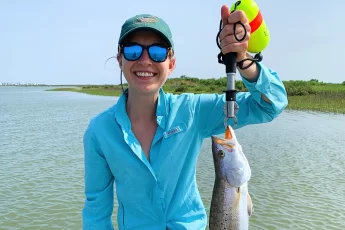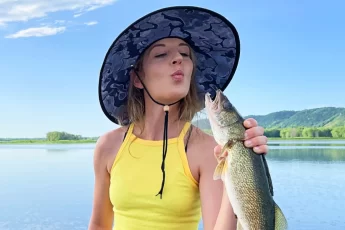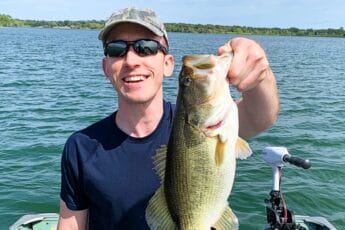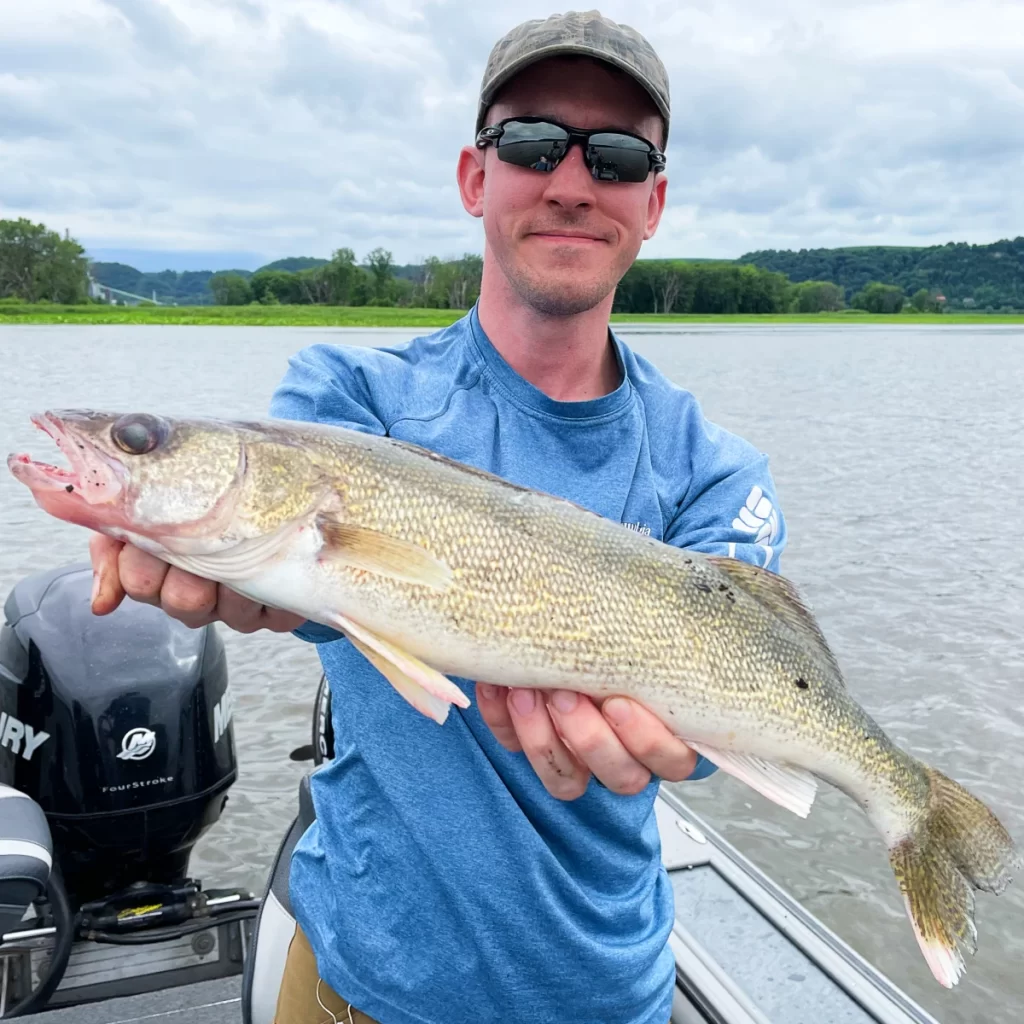
Walleye are one of the most popular game fish in the United States. They are elusive to find, a blast to catch, and make incredible table fare. We’ve written this no-nonsense ultimate guide on how to catch walleye to help beginner and expert anglers alike to catch more walleye.
*Disclosure: I only recommend products I would use myself and all opinions expressed here are my own. This post may contain affiliate links that at no additional cost to you, I may earn a small commission.
Table of Contents
- What are Walleye?
- Why Fish for Walleye?
- Where to Find Walleye?
- How to Fish for Walleye?
- Essential Gear to Catch Walleye
- Walleye Fishing Tips
- Conclusion
What are Walleye?
Walleye are a freshwater species native to North America. They have a distinct olive-gold coloring and iconic glassy eyes designed for hunting in low-light conditions. Walleye inhabit cooler waters with sandy or rocky bottoms. They can grow to impressive sizes with the world record weighing 25 pounds, 4 oz. Most walleye caught by amateur anglers are between fifteen and twenty inches. Walleye are incredible table fare with tender, flaky meat.
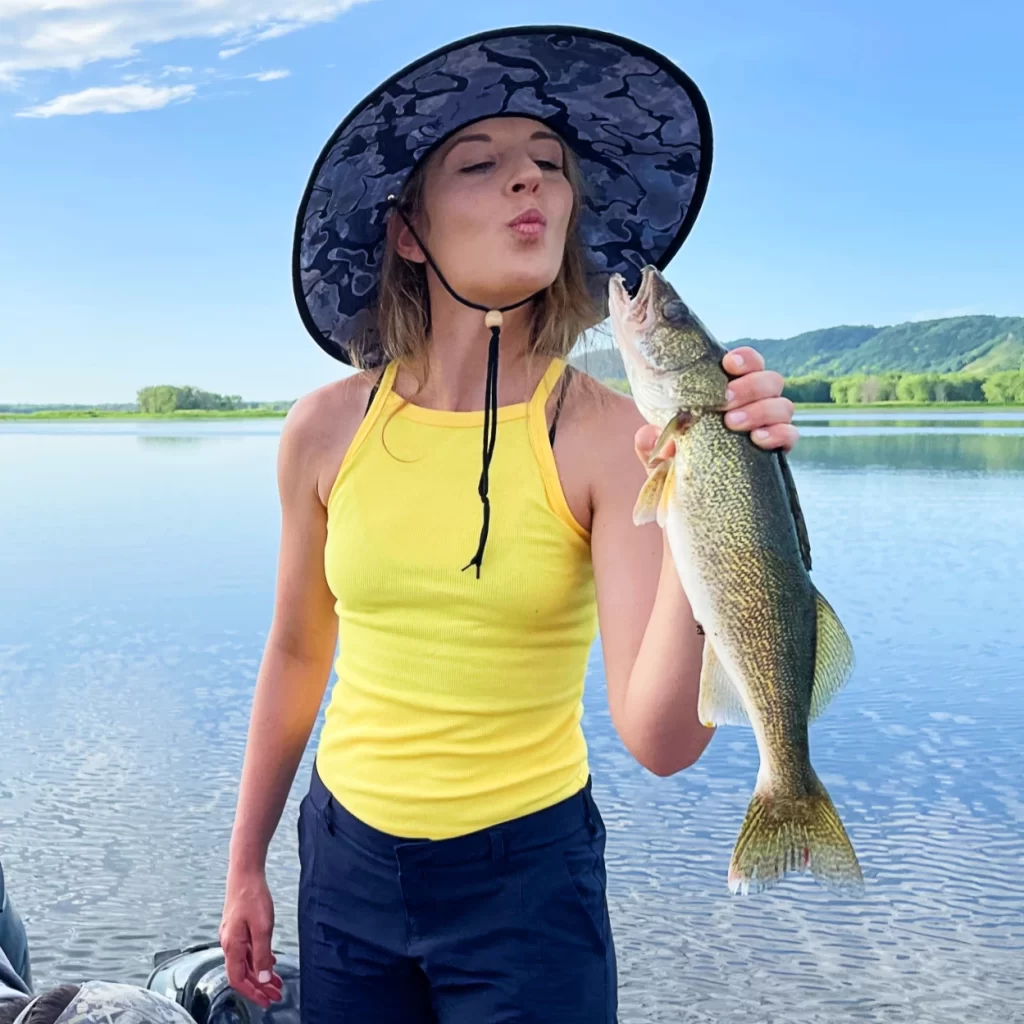
Walleye growth cycles vary depending on the size of their body of water, how much nutrition they have access to, and regional temperatures. By way of example, the Minnesota DNR reports Lake of the Woods Walleye of both sexes as reaching 12 inches long when they are three years old. Female walleye grow faster than male walleye and are generally 15 inches at 4 years old, 20 inches at 7 years old, 25 inches at 10 years old, and 30 inches at 20 years old. Male walleye are rarely over 24 inches long.
Incredibly, according to the US Fish and Wildlife Service, the oldest reported walleye was 29 years old!
Walleye primarily feed on small fish like yellow perch, aquatic invertebrates, and insects.
Why Fish for Walleye?
Walleye are a desirable gamefish because they’re challenging to catch and have delicious fillets. Walleye fishing techniques are so widely variable and exciting that many anglers spend 100% of their time targeting this elusive species. Additionally walleye are considered one of the best eating freshwater fish in the United States. Walleye fishing is fulfilling on every front.
Best Locations to Find Walleye
To find and catch walleye, anglers need to know both the geographic locations that hold walleye populations as well as the types of underwater habitat walleye prefer.
Walleye Geographic Range
Walleye prefer cool-water habitats. Walleye are native to the Great Lakes and Mississippi River basin areas. Human intervention such as stocking programs have expanded their presence to many non-native waters across the U.S. and Canada. This map of walleye range from the U.S. Geological Survey is a great visualization of the walleye’s modern range.
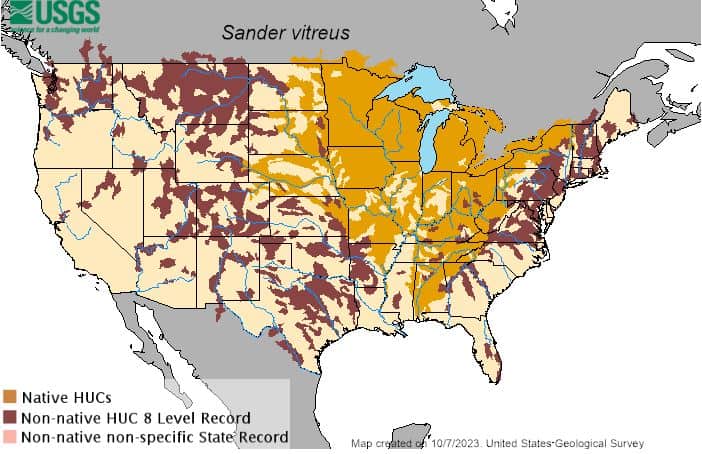
If you want to catch walleye, make sure you are fishing in a body of water that holds a healthy reproducing walleye population!
Want to see some of our favorite walleye spots in Wisconsin? Check out our data-backed article on top Wisconsin walleye fishing locations.
Walleye Preferred Habitat
Walleye have keen eyesight and gravitate towards deeper waters than many other fish species. While you may find largemouth bass waiting to ambush prey in thick weeds in two feet of water in the dead of summer, you will likely never catch a walleye in those conditions.
Walleye are inclined to prowl drop-offs, submerged rock structures, and deep vegetation in cooler water. In rivers, they are also commonly found in depth transitions in flowing water where they wait for bait to float into their waiting mouths!
In lower light conditions or during the spawn, walleye are known to venture into shallower zones like sandbars, gravel beds, and weed edges.
Understanding these habitat preferences is key for anglers trying to find and catch walleye.
How to Fish for Walleye: A Step-by-Step Guide
Being in the right location to catch walleye is only the first step! Next it is important to understand walleye behaviors, pick the right baits, and utilized ideal walleye fishing techniques.
1. Understanding Walleye Behavior
Walleye are primarily crepuscular, which means they are most active during dawn and dusk. Look for them moving up to shallower water during those times. Many anglers consider dawn and dusk the best time to fish for walleye.
During the heat of the day, walleye can be caught in deeper water. Our experience is there are certain locations walleye can be found at almost all times, and certain locations where walleye can only be found some of the time.
Try and find deeper structure on your body of water between four and twelve feet deep that hold water consistently. We have a few deep holes we fish on the Mississippi river that hold walleye in spring, summer, and fall. Additionally, some of the lakes we fish have rock piles that always hold walleye.
The common thread in these locations is they play to walleye’s strengths. There is security in deep structure so they feel safe, there is bait in these locations, and the dark conditions play to the strength of walleyes’ superior dark vision. Try and find these honey holes!
Expert Tip: Walleye are known for light strikes. Sensitivity is key for detecting bites. Walleye generally don’t hit bait as aggressively as a bass might.
During the spawn in spring when water temperatures reach 42 to 50 degrees Fahrenheit, walleye move up shallow to breed. This is a great time to fish the deeper side of weed edges with slip bobbers or jigs.
2. Choosing Baits & Lures
Choosing the right baits is key to catching walleye. In our experience, live bait like nightcrawlers, minnows, and leeches are the most effective. Live bait setups targeting walleye are most commonly fished on slip bobber rigs, drop shot rigs, and weighted fishing jig heads.
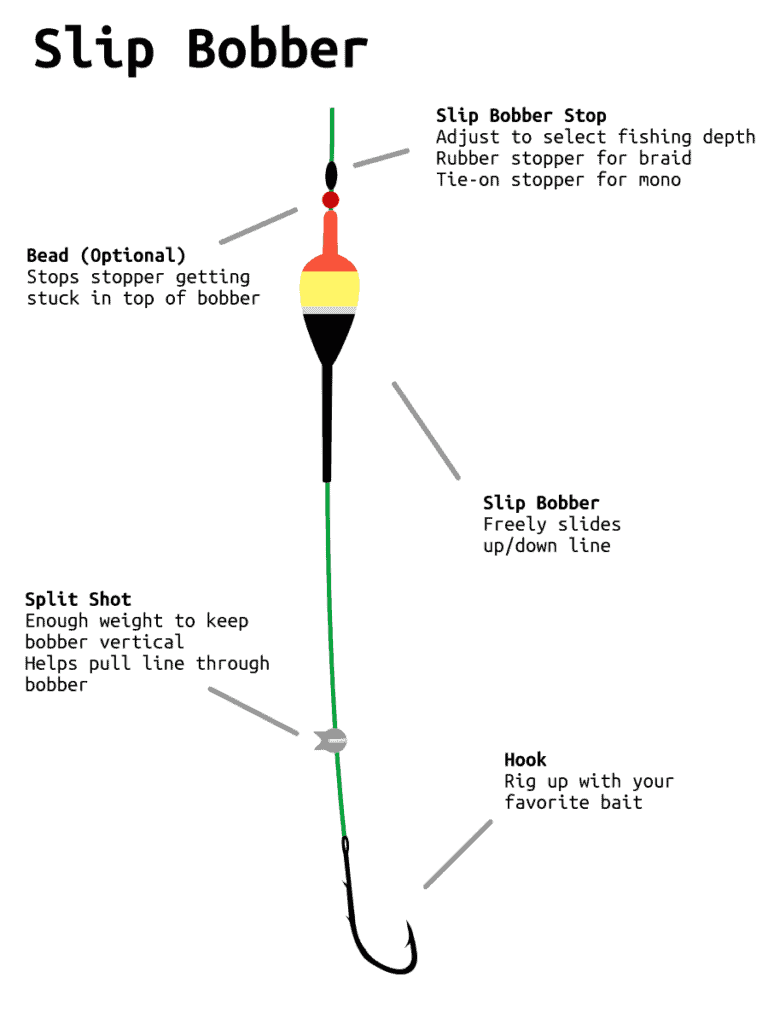
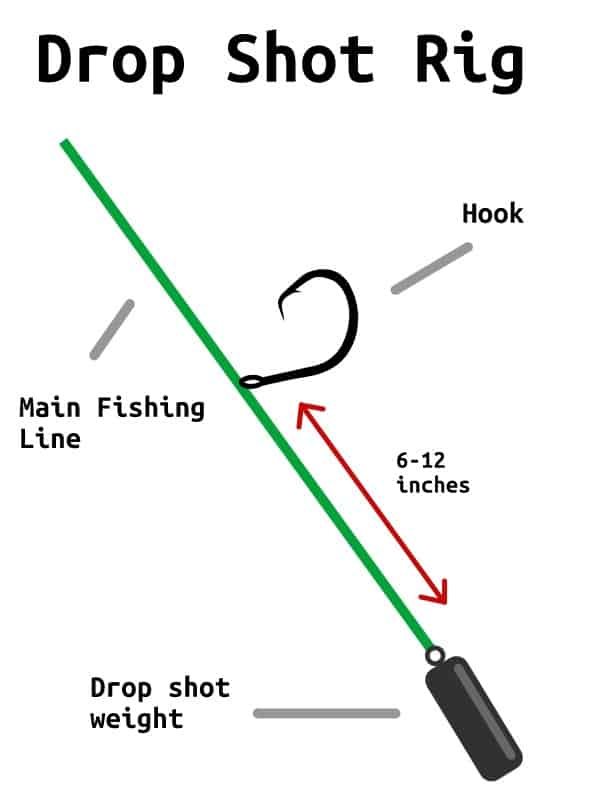
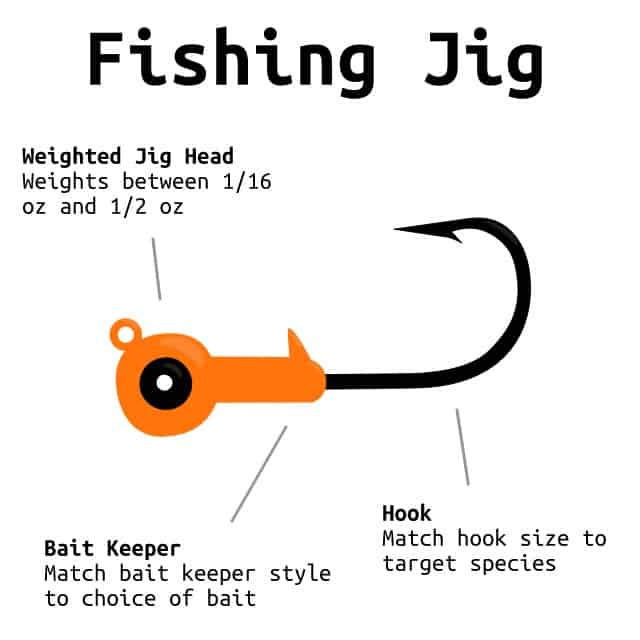
For those preferring artificial baits, jig heads can be rigged up with soft plastics like curly tailed grubs or crankbaits can be used for either casting or trolling for walleye.
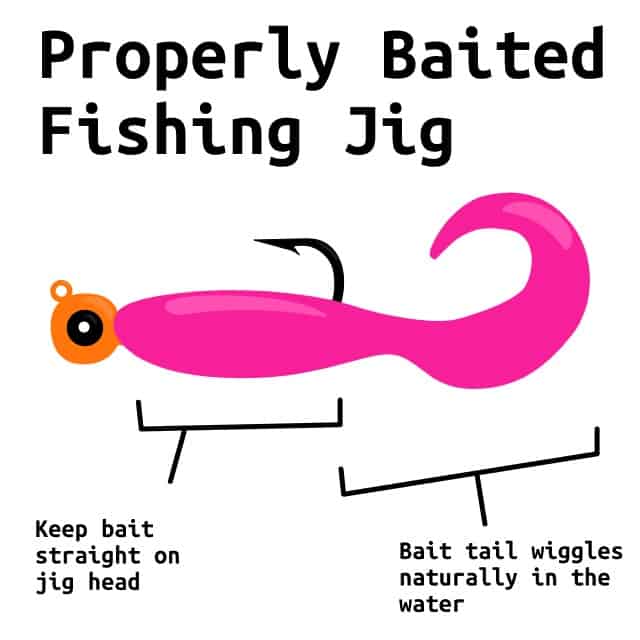
One of our favorite artificial baits for walleye on the Mississippi River is lipless crankbaits. We’ve found they are super effective fishing in two to four feet of flowing water near a drop-off where walleye are feeding on shad.
Pro Tip: Match the hatch! If you can find out what the walleye are feeding on, pick a bait that matches their natural prey.
Check out this incredible match the hatch example. We were catching 18 to 20 inch walleye all day on lipless crankbaits and one of them regurgitated a partially digested shad in the livewell. The shad was almost exactly the same size and shape as our lures! No wonder we were having such great success.
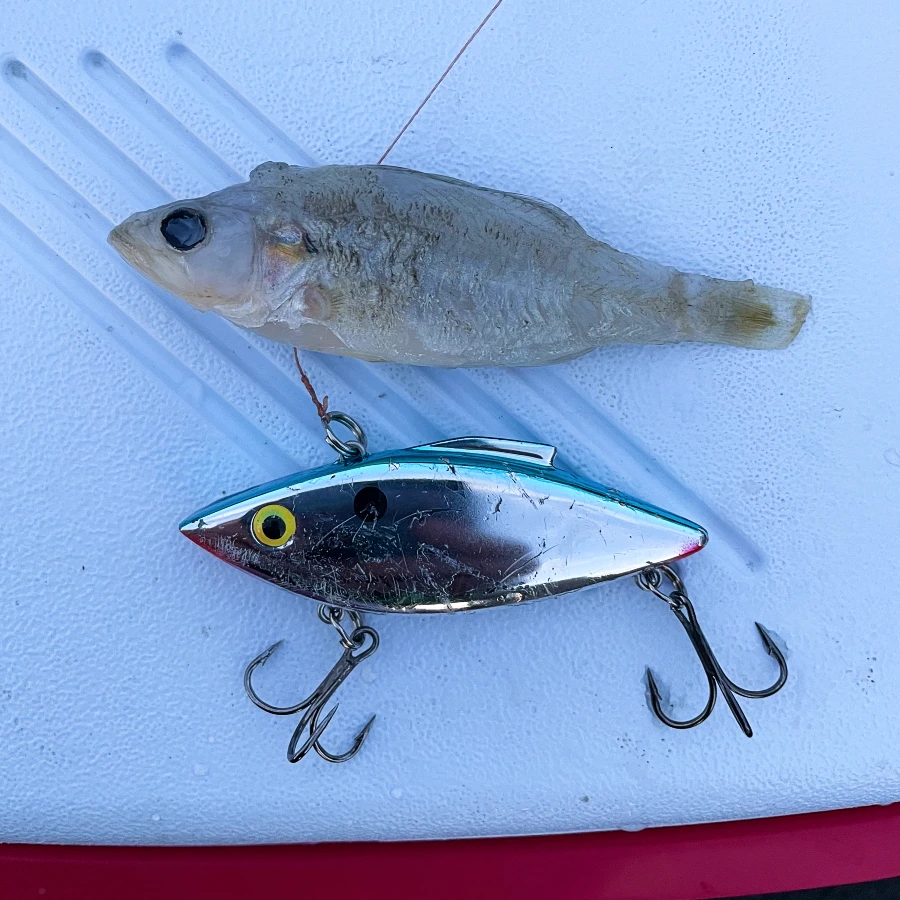
3. Techniques and Tactics
The most popular techniques and tactics to target walleye are jigging, slip bobbers, casting, and trolling.
Jigging
We use jig heads to fan cast over underwater structure on lakes and for fishing with the current on rivers. We especially like drifting with the current over depth changes between four and twelve feet water depth. We keep our line vertical with the jig ticking along the bottom which is also known as jigging. The walleye like to stack up on these depth changes waiting for bait.
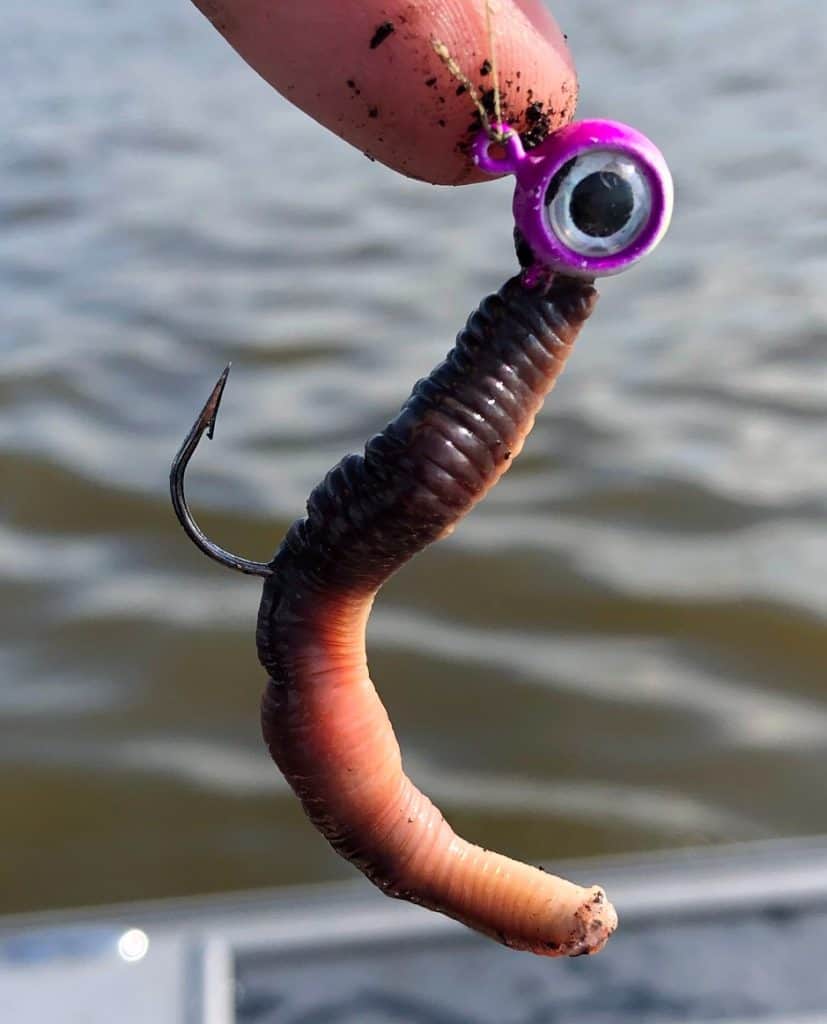
For static conditions, cast out and ‘jig’ the bait off the bottom by lifting up on your rod to bounce the jig across the bottom. Check out our article on jig fishing for a deeper dive on this effective walleye technique.
We think jigging is the most versatile walleye technique but it can require a skilled angler to use effectively. Jigging is difficult if bottom conditions have a ton of snags and newer anglers may struggle to differentiate a light walleye bite from bottom structure.
Slip Bobbers
Slip bobbers allow near-perfect depth control. We’ve found that setting the bait depth to four to six inches off bottom entices hungry walleye to strike (if they’re there that is!). Slip bobber rigs are super beginner friendly because the bait doesn’t have to get in contact with potential snags on the bottom.

Check out our article on slip bobbers for a deeper dive on how to use this rig to catch walleye.
Casting
Cast fishing for walleyes involves repeatedly casting and retrieving artificial baits. Common baits are crankbaits, spinners, and soft plastics on jig heads.
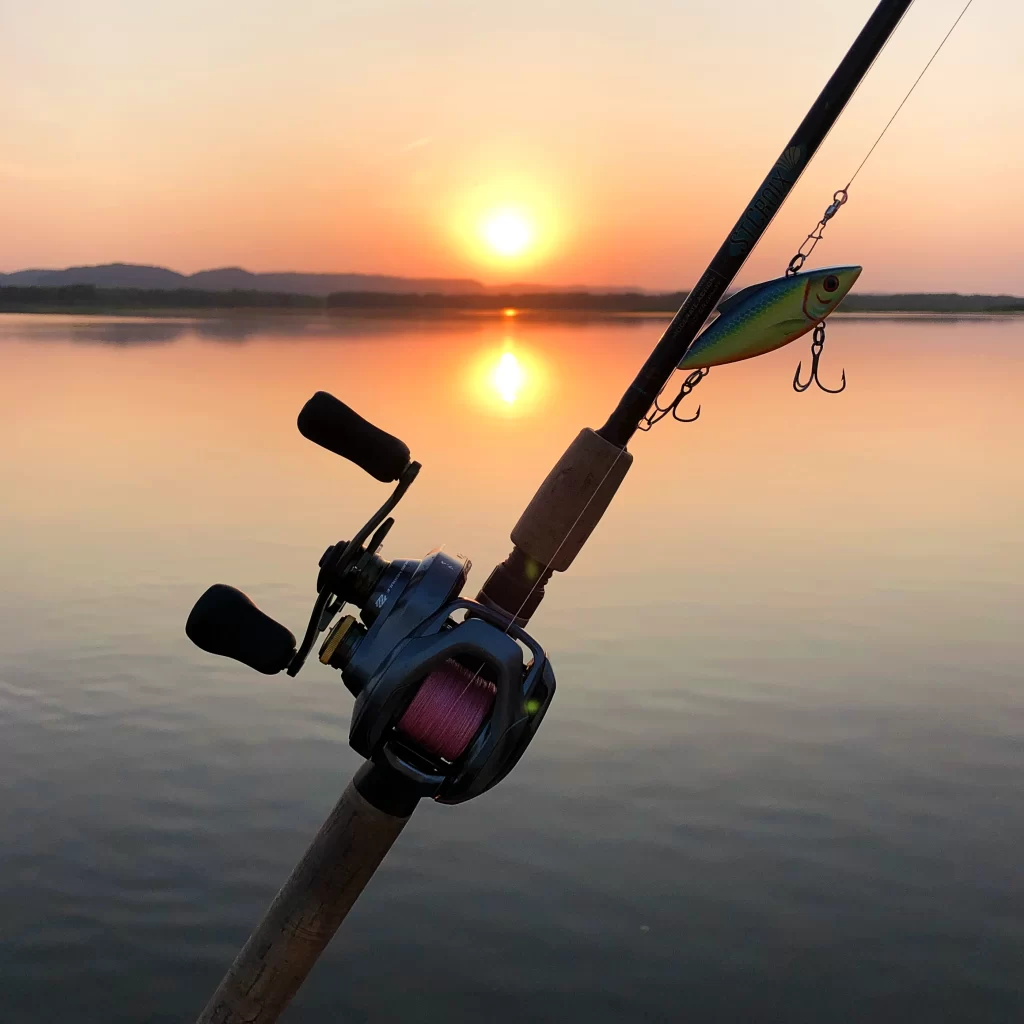
A major advantage of casting for walleye is how much water anglers can cover. Cast fishing allows great mobility to seek out areas that may hold walleye when compared to techniques like slip bobber fishing where it is more difficult to move.
Trolling
Trolling for walleye refers to pulling a bait or lure behind a slow moving boat. This is a popular technique for targeting walleye. The primary baits used for trolling are crankbaits, spinner rigs (harnesses), stickbaits, spoons, and soft plastic lures.
- Crankbaits: These are hard-bodied lures designed to mimic baitfish. They come in various sizes, shapes, and colors, each diving to a specific depth based on their design. Popular models for walleye include the Rapala Deep Husky Jerk, Berkley Flicker Shad, and the Bandit Walleye Deep.
- Spinner Rigs (or Harnesses): These typically consist of a series of beads, one or more spinner blades, and a hook or series of hooks. They can be trolled behind a weight or bottom bouncer to keep them near the lakebed. Often, a live bait like a nightcrawler or a minnow is added to the hook.
- Stickbaits: These are slender, hard-bodied lures that have a tight wiggling action when trolled. Examples include the Rapala Original Floater and Smithwick Rogues.
- Trolling Spoons: These are metal spoons that produce a fluttering action when trolled. While more common for trout and salmon, certain lighter and slimmer designs can be effective for walleye, especially if they are feeding on small baitfish.
- Soft Plastic Lures: While not as common as other trolling baits, soft plastics like swimbaits or large worms can be trolled behind a weight or diver.
Essential Gear for Walleye Fishing
In order to successfully catch walleye, anglers must have the right gear. All angler fishing kits start with a rod and reel but there are other considerations like line or accessories.
Best Walleye Rods
For jigging and casting, sensitivity is the most important factor in picking a walleye rod. This is because it’s important to feel the bottom and the slightest changes in weight that could be a soft walleye bite. Our favorite walleye rod for jigging and casting is a 7 foot, medium-light to medium power rod with a fast tip. Pick a spinning setup for live bait rigs and a spinning or baitcasting setup for casting setups.
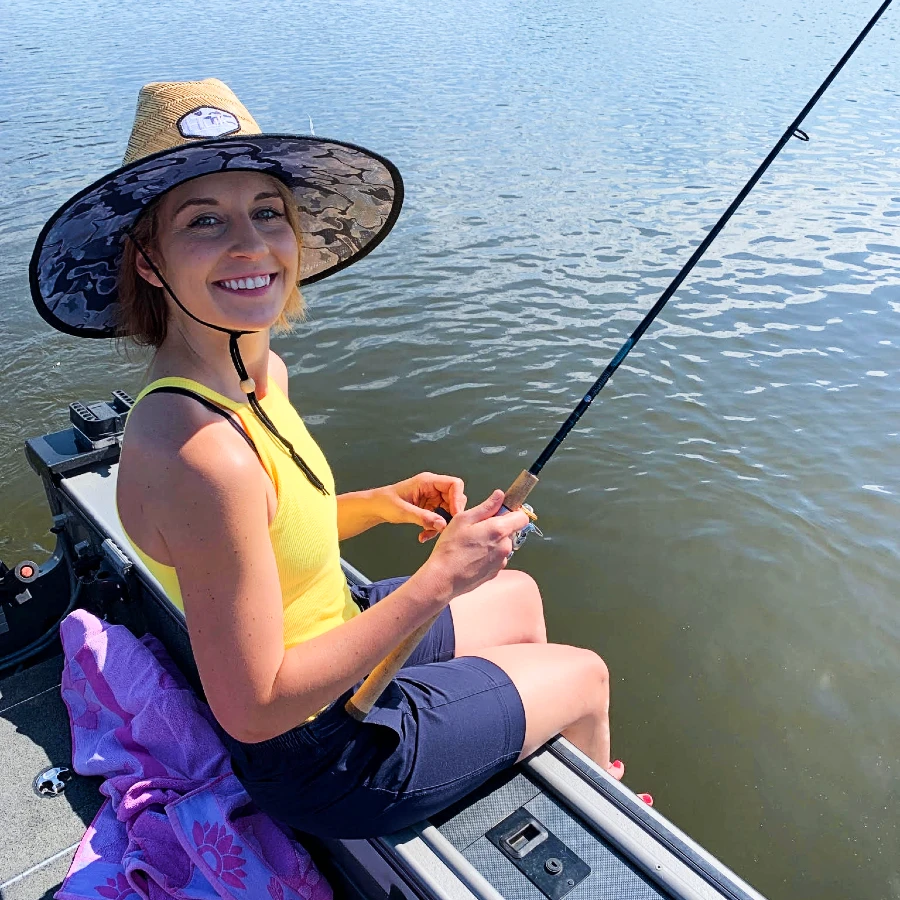
For trolling rigs, we recommend going with composite blank rods because they can handle the stresses of trolling better than purely graphite rods.
Want to explore great rod choices for walleye fishing? Check out our article on the best walleye rods for a deep dive on how to pick the right walleye rod for jigging, casting, or trolling.
Best Walleye Reels
Walleye reels need to match the type of rod. Most walleye techniques are best with a spinning reel around 3000 size, but for casting setups it is common to swap to a baitcasting reel. Pick a reel that has a smooth action so you can focus on fishing instead of fighting your equipment.
Want to explore great reel choices for walleye fishing? Check out our article on the best walleye reels for a deep dive on how to pick a reel to match your desired walleye fishing technique.
Best Walleye Line
The right line for walleye fishing depends on the fishing technique. For jigging and casting we recommend braided line between 8 and 15 pound rating. This light line allows baits to get to appropriate depths while still having enough strength to handle a large walleye.
For trolling, it depends on the bait. Common lines for trolling are between 10 and 20 pound rated. Heavier, deeper diving baits require stronger line than lighter baits.
Walleye Fishing Tips
Over years of walleye fishing we’ve picked up a few walleye fishing tip tidbits we think are useful:
- Time of Day Matters: Walleye are most active during dawn and dusk. Focus your efforts during these low-light periods.
- Use Live Bait: Nightcrawlers, minnows, and leeches are super effective choices for walleye.
- Fish the Right Depth: During warm days, walleye tend to stay in deeper, cooler waters. Adjust your bait depth accordingly.
- Low-Light Vision: Walleye have exceptional vision in low light, which makes overcast days or murky waters ideal for fishing them.
- Match the Hatch: Observe local baitfish species and sizes. Choose lures that mimic them.
- Sense Light Bites: Walleye are known for their subtle bites. Use a sensitive rod to detect these soft tugs.
- Seasonal Movements: During spawning in the spring, walleye move to shallower waters. Adjust your location based on the season.
- Structure is Key: Walleye often congregate around underwater structures like drop-offs, rock piles, and deep vegetation.
- Jigging Technique: Maintain a vertical line and let the jig touch the bottom occasionally. This mimics a baitfish’s natural movement.
- Weather Watch: Walleye can be more active before a storm. Barometric changes often trigger feeding activity.
- Walleye Chop: Walleye are known to more actively feed when there is a slight chop on the water.
- Use Electronics: Modern fish finders can pinpoint walleye locations and help identify underwater structures where they might congregate.
- Trolling Speed: When trolling for walleye, maintain a speed of 1.5 to 2.5 mph for optimal results.
- Line Choice: Braided line offers sensitivity and strength, making it a top choice for feeling those light walleye bites.
- Change It Up: If a technique or lure isn’t working, don’t hesitate to switch it up. Walleye can be finicky and might respond to different presentations.
- Stay Patient: Walleye fishing can be a game of patience. Even if the bite is slow, persistence often pays off.
- Land Walleye Quickly: Walleye have tough mouths and sometimes don’t hook up well. Minimize time reeling in a walleye to reduce chances of losing a poorly hooked fish.
Conclusion
Even after a combined 100 plus years of angling, the Juran Clan feels like we still have more to learn about the elusive walleye. We’ve keyed into many effective techniques that keep our freezer well stocked with walleye fillets but we still feel like we learn something new every time we get out on the water. Hopefully our knowledge and experience on where to find walleye and how to target them was helpful!
What are you waiting for? Get out there and catch some walleye!
Check out our related articles to round out your walleye fishing knowledge:
- Best Walleye Rods
- Best Walleye Reels
- Best Walleye Fishing Spots in Wisconsin
- How-To: Slip Bobber Fishing
- How-To: Jig Fishing
- How-To: Lipless Crankbait Fishing
- How-To: Fillet Fish
Walleye Fishing Frequently Asked Questions
- What’s the best time of year to fish for walleye?
- Spring and fall are often considered the best times, especially during their spawning season in spring when they move to shallower waters.
- Where can I find walleye in a lake?
- Walleye are often found near underwater structures like drop-offs, rock piles, and weed beds. In warmer months, they may move to deeper, cooler waters.
- What color lures are best for walleye fishing?
- While walleye may strike various colors, many anglers find success with natural colors like silver, white, and black, as well as chartreuse, orange, and green.
- What size hook should I use for walleye?
- Hook sizes ranging from #4 to #2 are common for walleye, but the best size can depend on the bait you’re using.
- Are walleye more active during the day or night?
- Walleye are typically most active during dawn and dusk, but they can also be caught at night, especially on well-lit nights or under dock lights.
- How can I tell a male walleye from a female?
- Males are generally smaller and slimmer, while females tend to be larger with a more rounded belly, especially during spawning season.
- Do I need a special fishing license to catch walleye?
- Licensing requirements vary by region. Always check local regulations. Some areas may require a specific stamp or permit for walleye.
- How do you properly handle a walleye for catch and release?
- Use a net to land the fish, handle with wet hands to protect their slime coat, and avoid squeezing the fish or touching their gills. Use pliers to quickly remove the hook and return the fish to the water promptly.
- Is it true that walleye have sharp teeth?
- Yes, walleye have a mouthful of sharp teeth. It’s advisable to handle them with care and possibly use a lip grip or pliers when unhooking them.
- Do walleye have natural predators?
- While adult walleye have few natural predators, young walleye can fall prey to larger fish like pike, muskie, and even other walleyes.

Written By: Andrew Juran
Andrew is a seasoned angler with over 25 years of experience specializing in walleye fishing on the Mississippi river and assorted lakes in northern Wisconsin. He has caught hundreds of walleye using various techniques and mentored many in the art of walleye fishing. An advocate for sustainable fishing, Andrew is an active member of the Coastal Conservation Association, an organization committed to marine conservation.
For frequent fishing tips, behind-the-scenes looks, and real-time catches, connect with Andrew on Instagram


